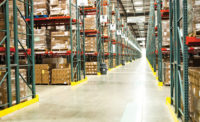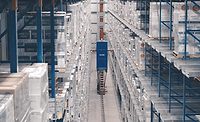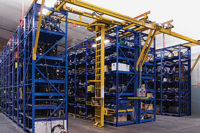Storage systems accommodate growing facilities, SKU proliferation
Automated storage systems gain popularity within beverage facilities

Growth and change in the beverage market has created trends that impact not only new product development and packaging design, but also extend into warehouse and distribution centers. Among these trends, SKU proliferation, labor and consolidation have impacted beverage warehouse storage in recent years, experts note.
“The impact of labor availability, employee’s lack of desire to pick cases, and extreme SKU growth have been major trends effecting storage, replenishment and picking within the beverage industry,” says Tom Steininger, market development director at Dematic North America, Grand Rapids, Mich. “Mergers and acquisitions within the industry have created some very large companies, which has impacted the complexity of their operations due to added brands, delivery route size [and] fulfillment requirements, all of which can impact service levels if not handled properly.”
Rick Graff, senior product manager at Honeywell Intelligrated, Mason, Ohio, notes that SKU proliferation has resulted in order downsizing. He also highlights that storage has progressed from full pallets of a single SKU years ago, to today, where warehouses are building mixed cases for an order.
Storage technology is challenged to be more flexible to accommodate the increased inventory, Graff adds. He says that beverage facilities need to think outside of the box to best utilize their space.
“The influx of SKUs drives operations to implement creative methods of managing storage location size,” he says. “As product sizes, counts and SKU velocities regularly change, the amount of storage for one version of a product evolves. As those variations occur, the space may now need to be used to store a different size. Being creative in how to allocate the available space can help reduce the overall footprint of the storage system.”
Beverage warehouses also are growing in size and scope. In some areas, like urban markets, square-footage is limited so vertical expansion often is implemented. This growth has had a significant impact on storage systems, experts say.
“Rite-Hite has noticed for several years now that more of our ccustomers, including beverage manufacturers, are building up rather than out,” says Andy Olson, aftermarket director of marketing at Rite-Hite, Milwaukee. “Whether it’s being done to save cost or because there’s no room for outward expansion, new data from CBRE, the world’s largest real estate group, shows that warehouses today are nearly 9 feet taller than those built in the 1960s and a full 3 feet taller than those built in 2010.”
Consolidation within the beverage industry also has contributed to facilities growing taller, says Skip Eastman, president and chief executive officer of Twinlode, South Bend, Ind.
“There’s a great deal of consolidation that’s going on within the warehousing in the beverage industry, and we see that with a number of our clients,” he says. “What they’re trying to do is bring everything into a more central location rather than having multiple locations in a given area. By doing that, they can manage it better.”
Fully auto
Although not suitable for all beverage facilities, automated storage systems have gained popularity, experts say.
This heightened interest might be attributable to automation’s ability to enable growth and increase density, says Dan Labell, president of Westfalia Technologies Inc., York, Pa. An outlier just 10 to 15 years ago, automation has become mainstream in recent years, Labell says.
“I think it’s because, No. 1, that type of automation will generally facilitate growth of some type,” he explains. “For example, a lot of beverage folks have local markets that they service that are in highly populated areas, so the density of the storage and being able to go up high might enable them to be able to do something in an existing site that they might not have been able to do before.”
Automation can offer several other benefits, such as labor reduction, order accuracy, higher customer service levels, reduced route driver times and the ability to handle smaller orders with more SKUs, Dematic’s Steininger says.
Automated storage systems can be ideal for taller facilities looking to utilize vertical storage space, says Bruce Bleikamp, sales manager at Cimcorp NA, Grimsby, Ontario. In fact, they can be as tall as 120 feet, he says.
Automation also can benefit warehouses that are challenged by high turnover of personnel, Bleikamp notes.
“Automation has been used to save the footprint the warehouse uses, but I think more importantly, automation is replacing people in environments where it seems people are less interested in working these days,” he explains. “Picking and placing boxes on a repetitive basis is a position where high turnover is the norm and can make staffing an on-going issue. The need to constantly bring in new people with the associated training and ramp-up time leads to inefficiencies and inaccuracies in the order fulfillment area of the warehouse.”
Westfalia’s Labell also notes the solutions that automation can offer to facilities with labor challenges. But, he adds that this often is dependent on geographic location and not all beverage operations are facing this challenge.
However, the objective of automation is not to reduce the staff size in a warehouse, Twinlode’s Eastman says.
“It’s never been our objective to reduce the number of employees in a warehouse. It’s to improve productivity, and if there are employees that are no longer used in one area, we would hope that they would be used in another area of manufacturing,” Eastman says.
Although automation usage is experiencing a noticeable uptick, full automation might not be the solution for every facility. It’s important to keep in mind that every beverage facility requires its own unique solutions, experts note.
“Each operation looks at different factors that are important to them, and if you’re in a very expensive market for real estate, construction [or] labor, the [automated storage and retrieval systems] comes across as very attractive,” says Paul Laman, vice president and director of the Food and Beverage division at DMW&H, Fairfield, N.J. “If the real estate is not so bad and the construction costs not so bad, then some just have very tall rack systems with narrow aisles. There’s different [return-on-investments] in each marketplace and there’s different priorities for each distributor.”
Consider this
When selecting a storage system, many considerations should be made. Instead of going into a project with a particular storage solution in mind, companies should look at the problem in each application to determine what solution will best improve density and productivity for that application, Twinlode’s Eastman explains.
With various types of storage systems available, beverage-makers should take the time to find the right solution for an individual application’s needs.
“Storage systems come in a wide range of technologies, from single-deep and double-deep arrangements to deep-lane shuttle technologies,” Cimcorp’s Bleikamp says. “For case handling, there are also mini-loads for single-deep, double-deep as well as shuttle applications. Many of these can handle just about any size package seen in a beverage warehouse.”
Partnering with a knowledgeable supplier also is crucial for beverage facilities. Experts note several considerations to make when selecting a supplier.
“[A company] should consider the experience and reliability of the supplier,” Bleikamp says. “Where will support come from if and when needed? Do they have the appropriate level of resources to service all of their clients and have the systems in place to get the right resources to the right place in a timely manner?”
Finding a partner with a proven track record as well as a forward-thinking and an analytical skill set is essential, Westfalia’s Labell says. He also suggests that beverage facilities consider the value of their investment instead of the price.
DMW&H’s Laman highlights the importance of analytics and says companies should analyze their system prior to implementing new solutions.
“[A company should have] a good understanding of their inventory level and the number of SKUs required currently and a good projection for the future,” he explains.
Without good analysis, facilities might misapply automation, which results in lower returns than expected, Eastman says.
“On some of our observations, we’ve [seen] the misapplication of automation ... as possibly people didn’t do their due diligence to analyze what they needed to accomplish, what their goals or objectives were for the warehouse. They have, in some cases, applied equipment that is not servicing what their return-on-investment projections were,” he says. “… The second thing that we’ve seen is pressure from upper management to improve productivity, and there’s not a lot of analytics that are placed on how they improve their productivity, therefore, they don’t get the same return out of it as what they had intended to get.”
As buildings get taller, safety becomes more important, Rite-Hite’s Olson notes. When facility managers are considering a storage system, especially those that are elevated, safety should be at the top of their priorities, he says.
“One of the first considerations a company should make when selecting a storage system are potential safety issues and how easily and efficiently they can be addressed,” he says. “For instance, with mezzanines and elevated pick modules, there are several very straightforward, easily implemented solutions involving the use of reciprocating barriers that create controlled access areas. This type of product keeps companies in compliance with OSHA, IBC and ANSI standards while also protecting workers from a dangerous fall.”
With warehouses growing, Rite-Hite has experienced increased demand for products like its GateKeeper Mezzanine Safety Gate and RacKeeper Safety Gate, Olson says.
When considering improvements to storage operations, Dematic’s Steininger suggests starting with a warehouse management system with labor management.
“If the software is not in place, it will provide you with tools to get you on the road to improvement,” he says. “Improvements to various types of storage, along with slotting software, can greatly improve the space utilization and warehouse efficiency. One storage strategy for all SKUs, including fast-, medium- and slow-movers, is certainly not a good plan.” BI
Looking for a reprint of this article?
From high-res PDFs to custom plaques, order your copy today!






